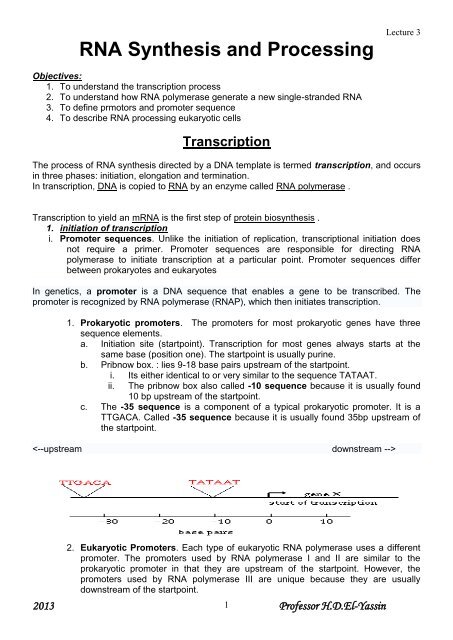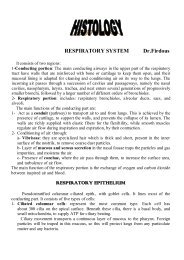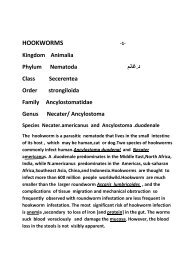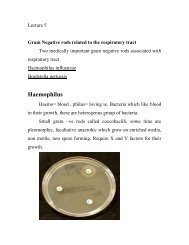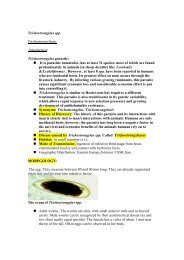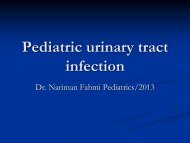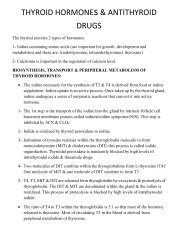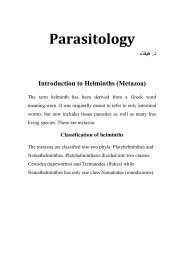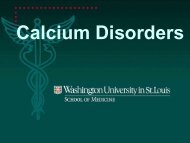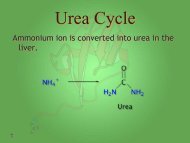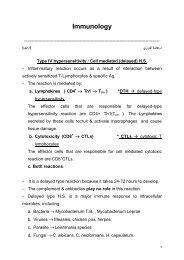RNA Synthesis and Processing
RNA Synthesis and Processing
RNA Synthesis and Processing
Create successful ePaper yourself
Turn your PDF publications into a flip-book with our unique Google optimized e-Paper software.
<strong>RNA</strong> <strong>Synthesis</strong> <strong>and</strong> <strong>Processing</strong>Lecture 3Objectives:1. To underst<strong>and</strong> the transcription process2. To underst<strong>and</strong> how <strong>RNA</strong> polymerase generate a new single-str<strong>and</strong>ed <strong>RNA</strong>3. To define prmotors <strong>and</strong> promoter sequence4. To describe <strong>RNA</strong> processing eukaryotic cellsTranscriptionThe process of <strong>RNA</strong> synthesis directed by a DNA template is termed transcription, <strong>and</strong> occursin three phases: initiation, elongation <strong>and</strong> termination.In transcription, DNA is copied to <strong>RNA</strong> by an enzyme called <strong>RNA</strong> polymerase .Transcription to yield an m<strong>RNA</strong> is the first step of protein biosynthesis .1. initiation of transcriptioni. Promoter sequences. Unlike the initiation of replication, transcriptional initiation doesnot require a primer. Promoter sequences are responsible for directing <strong>RNA</strong>polymerase to initiate transcription at a particular point. Promoter sequences differbetween prokaryotes <strong>and</strong> eukaryotesIn genetics, a promoter is a DNA sequence that enables a gene to be transcribed. Thepromoter is recognized by <strong>RNA</strong> polymerase (<strong>RNA</strong>P), which then initiates transcription.1. Prokaryotic promoters. The promoters for most prokaryotic genes have threesequence elements.a. Initiation site (startpoint). Transcription for most genes always starts at thesame base (position one). The startpoint is usually purine.b. Pribnow box. : lies 9-18 base pairs upstream of the startpoint.i. Its either identical to or very similar to the sequence TATAAT.ii.The pribnow box also called -10 sequence because it is usually found10 bp upstream of the startpoint.c. The -35 sequence is a component of a typical prokaryotic promoter. It is aTTGACA. Called -35 sequence because it is usually found 35bp upstream ofthe startpoint.2. Eukaryotic Promoters. Each type of eukaryotic <strong>RNA</strong> polymerase uses a differentpromoter. The promoters used by <strong>RNA</strong> polymerase I <strong>and</strong> II are similar to theprokaryotic promoter in that they are upstream of the startpoint. However, thepromoters used by <strong>RNA</strong> polymerase III are unique because they are usuallydownstream of the startpoint.2013 1 Professor H.D.El-Yassin
Lecture 3ii. Initiation factors:1. Prokaryotic σ factor is required for accurate initiation of transcription.2. Eukaryotic initiation factors: the initiation of transcription in eukaryotes isconsiderably more complex than in prokaryotes, partly because of the increasedcomplexity of eukaryotic <strong>RNA</strong> polymerases <strong>and</strong> partly because of the diversity oftheir promoters.2. Elongation:The basic requirement <strong>and</strong> fundamental mechanism of the elongation phase of <strong>RNA</strong> synthesisis the same in prokaryotes <strong>and</strong> eukaryotes.1) Template: A single str<strong>and</strong> of DNA acts as a template to direct the formation ofcomplementary <strong>RNA</strong> during transcription.2) Substrates: the four nucleosides triphosphates are needed as substrates for <strong>RNA</strong>synthesis.3) Direction of synthesis: <strong>RNA</strong> chain growth proceeds in the 5' to 3' direction.4) Enzyme:a. Prokaryotes have a single <strong>RNA</strong> polymerase responsible for all cellular synthesis.Thestructure of <strong>RNA</strong> polymerase is complex:b. Eukaryotes have one mitochondrial <strong>and</strong> three nuclear <strong>RNA</strong> polymerase. The latterare distinct enzymes that function to synthesize different <strong>RNA</strong>s.3. Termination:i. In prokaryotices:There are two basic classes of termination event in prokaryotes1. Intrinsic termination (Rho-independent termination) involves terminator sequences within the<strong>RNA</strong> as it is being made that signal the <strong>RNA</strong> polymerase to stop. The terminator sequenceis usually a palindromic DNA sequence that forms a hairpin.2. Rho-dependent termination uses a termination factor called ρ factor to stop <strong>RNA</strong> synthesisat specific sites. When ρ-factor reaches the <strong>RNA</strong>P, it causes <strong>RNA</strong>P to dissociate from theDNA, terminating transcription.2013 2 Professor H.D.El-Yassin
Lecture 3ii. In eukaryotices: Very little is known about how they terminate transcription2013 3 Professor H.D.El-Yassin
Posttranscriptional <strong>RNA</strong> processingLecture 3Once a gene transcript has been synthesized, numerous post-transcriptional modification orprocessing events may be needed before the transcript is functional.1. Prokaryotes: post-transcriptional processing of <strong>RNA</strong> is not as extensive in prokaryotesas in eukaryotes; however, some processing does occur.2. Eukaryotes: Overall, post-transcriptional processing is more extensive in eukaryotesthan in prokaryotes. This partly is due to the presence of a nucleus from which most<strong>RNA</strong>s must be transported. <strong>RNA</strong>s are processed during this transport. <strong>Processing</strong> givesthem the characteristics they need to be functional in the cytoplasm such as anincreased stability of m<strong>RNA</strong>s as well as allowing for another level of gene regulation.a. The primary transcript (hn<strong>RNA</strong>) is capped at its 5' end as it is being transcribed.b. A poly (A) tail, 20 to 200 nucleotide in length is being added to the 3' end of hetranscript.c. Splicing reactions remove introns <strong>and</strong> connect the exons.(The most common cause of -thalassemia are defects in m<strong>RNA</strong> splicing of the -globin gene.Mutations that affect the splicing create aberrant transcript that are degraded before they aretranslated. If patients inherit a single mutant gene thalassemia minor, the disease manifestsitself with a mild anemia. However, patents with homozygous mutations thalassemia majorhave sever transfusion-dependent anemia.2013 4 Professor H.D.El-Yassin
2013 5 Professor H.D.El-YassinLecture 3
Lecture 3Conclusion:1. <strong>Synthesis</strong> of <strong>RNA</strong> from a DNA template is called transcription2. Genes are transcribed by enzymes called <strong>RNA</strong> polymerases that generate a singlestr<strong>and</strong>ed<strong>RNA</strong> identical in sequence (with the exception of U in place of T) to one of thestr<strong>and</strong>s of the double-str<strong>and</strong>ed DNA. The DNA str<strong>and</strong> that directs the sequence ofnucleotides in the <strong>RNA</strong> by complementary base-pairing is the template str<strong>and</strong>. The<strong>RNA</strong> str<strong>and</strong> that is initially generated is the primary transcript. The DNA template iscopied in the 3' to 5' direction, <strong>and</strong> the <strong>RNA</strong> transcript is synthesized in the 5' to 3'direction. <strong>RNA</strong> polymerases differ from DNA polymerases in that they can initiate thesynthesis of new str<strong>and</strong>s in the absence of a primer.3. In addition to catalyzing the polymerization of ribonucleotides, <strong>RNA</strong> polymerases mustbe able to recognize the appropriate gene to transcribe, the appropriate str<strong>and</strong> of thedouble-str<strong>and</strong>ed DNA to copy, <strong>and</strong> the startpoint of transcription . Specific sequenceson DNA, called promoters, determine where the <strong>RNA</strong> polymerase binds <strong>and</strong> howfrequently it initiates transcription. Other regulatory sequences, such as promoterproximalelements <strong>and</strong> enhancers, also affect the frequency of transcription.4. In bacteria, a single <strong>RNA</strong> polymerase produces the primary transcript precursors for allthree major classes of <strong>RNA</strong>: messenger <strong>RNA</strong> (m<strong>RNA</strong>), ribosomal <strong>RNA</strong> (r<strong>RNA</strong>), <strong>and</strong>transfer <strong>RNA</strong> (t<strong>RNA</strong>). Because bacteria do not contain nuclei, ribosomes bind to m<strong>RNA</strong>as it is being transcribed, <strong>and</strong> protein synthesis occurs simultaneously with transcription.Eukaryotic genes are transcribed in the nucleus by three different <strong>RNA</strong> polymerases,each principally responsible for one of the major classes of <strong>RNA</strong>. The primary transcriptsare modified <strong>and</strong> trimmed to produce the mature <strong>RNA</strong>s. The precursors of m<strong>RNA</strong>(called pre-m<strong>RNA</strong>) have a guanosine “cap” added at the 5_-end <strong>and</strong> a poly(A) “tail” atthe 3_-end. Exons, which contain the coding sequences for the proteins, are separatedin pre-m<strong>RNA</strong> by introns, regions that have no coding function. During splicingreactions, introns are removed <strong>and</strong> the exons connected to form the mature m<strong>RNA</strong>. Ineukaryotes, t<strong>RNA</strong> <strong>and</strong> r<strong>RNA</strong> precursors are also modified <strong>and</strong> trimmed, although not asextensively as pre-m<strong>RNA</strong>.Nice to know:Clinical case:Anne Niemick is a 4-year-old girl of Mediterranean ancestry whose height <strong>and</strong> body weight are belowthe 20th percentile for girls of her age.She is listless, tires easily, <strong>and</strong> complains of loss of appetite <strong>and</strong> shortnessof breath on exertion. A dullpain has been present in her right upper quadrant for the last 3 months. Her complexion is slate-gray<strong>and</strong> she appears pale. Initial laboratory studies indicate a severe anemia (decreased red blood cellcount) with a hemoglobin of 6.2 g/dL (reference range, 12–16). A battery of additional hematologic testsshows that Anne has + -thalassemia, intermediate type.The thalassemias are a heterogenous group of hereditary anemias that constitute the most commongene disorder in the world, with a carrier rate of almost 7%. The disease was first discovered in countriesaround the Mediterranean Sea <strong>and</strong> was named for the Greek word “thalassa” meaning “sea”. However, itis also present in areas extending into India <strong>and</strong> China that are near the equator. The thalassemiasyndromes are caused by mutations that decrease or abolish the synthesis of the or chains in theadult hemoglobin A tetramer. Individual syndromes are named according to the chain whose synthesis isaffected <strong>and</strong> the severity of the deficiency. Thus, in° thalassemia, the superscript 0 denotes none ofthe chain is present; in + thalassemia, the + denotes a partial reduction in the synthesis of the chain.More than 170 different mutations have been identified that cause thalassemia; most of these interferewith the transcription of -globin m<strong>RNA</strong> or its processing or translation.2013 6 Professor H.D.El-Yassin


